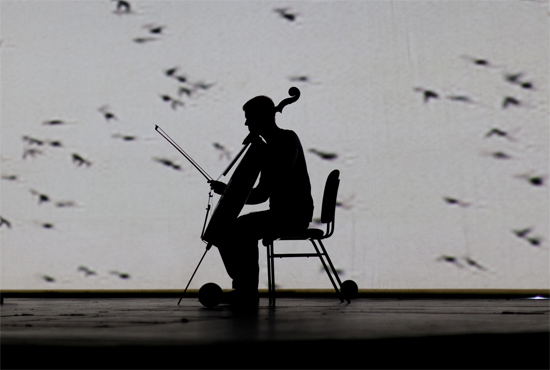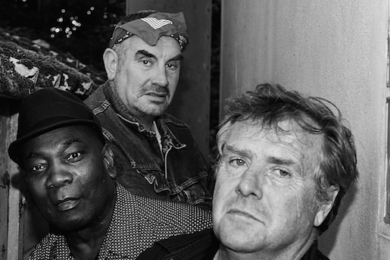A gigantic metal curtain towers over the audience, sealing off the stage and reflecting every light like a vertical lake of oil. In front of it, a man stands absolutely still with his back to us, looking very much like one of Survivor co-creator Antony Gormley’s minimalist statues. As the lights dim, the curtain splits in two and retracts revealing a row of dimly-lit people who stare out and hum like Buddhist monks. The man in front of them remains impassive. One by one the ‘singers’ break away and run up ladders to towering scaffolds where instruments await them. The static man starts to jerk and spasm in a terrifying parody of classical dance. The musicians begin a pounding, drum-heavy rock motif. One man remains behind. Clutching a microphone, he hisses and shouts, also contorting his body like a possessed exorcist. The stage lights come on to reveal Shechter’s outlandish orchestra: two string quartets battling with a myriad drum kits, a gigantic gong, two electric guitarists and a man cranking out drones from a laptop and synths. The musicians lock into a sweeping, majestic post-rock groove, somewhere between Godspeed You! Black Emperor and Yndi Halda (I kid you not), building and building as our two protagonists seem lost in their own physical nightmare. At one point, dancers explode out of the stage floor, twisting and twirling to the music’s furious melody. When the piece comes crashing to a halt, the lights going off suddenly and the metal barrier closing once again, I am startled to find tears running down my cheeks. This was not what I expected.
To be honest, though, I’m not sure what I expected. There was much publicity around this meeting of minds, so the fact that the music was anchored at times in the ‘rock’ tradition should perhaps not come as a surprise. Conversely, Shechter and Gormley are renowned in their fields for their boundary-pushing approaches to their art, so the minimal decor and jerky, unusual dancing also felt apt.
Hofesh Shechter’s background is as a dancer and choreographer, but he has always composed his music. This, however, was his first shot at basing a piece on music first, and dance later. As with previous work, drums were the focal point of his music, with about twenty various percussive instruments dotting the scaffolding stages. At one point, nearly 100 community drummers crowd the stage, pounding out polyrhythmic beats under the exhorting direction of longtime Shechter collaborator Yaron Engler. In contrast, the string arrangements were often muted and mournful, emphasising the darker areas of Shechter and Gormley’s vision.
There’s a narrative to Survivor, albeit one that is elusive and mostly understated. There are frequent references to the Iraq war, at times about as subtle as a sledgehammer to the gut, but mostly restricted to hints and potent symbolism. Early on, footage of explosions over Baghdad is followed by a dancer dragging a bathtub across a stage. The man crawls into it and curls up like a foetus, his harsh breathing oppressively amplified. Later, five dancers march around the stage clutching or playing with heavy metal balls and hunched over like prisoners at Guantanamo. At the end, one dancer is carried onto the stage and laid down in front of a pit of light (Heaven or Hell?), one of the string quartets surrounding him and playing a suitably funereal tune. On a giant screen we see images of flocks of birds, waterfalls, the sea: they bring a sense both of permanence and finality, being both monolithic and impossible to grasp. It’s something I felt very strongly when I entered Antony Gormley’s mist-filled White Light installation room. The mist was there, surrounding me, inevitable, but at the same time I obviously couldn’t grasp it. Such visions of the eternal – tied into the word ‘Survivor’, the individual who suffers continually but still remains – gave force to the reflections on war and death, and were beautifully underscored by the music.
The moment when the drummers fill the front of the stage and play off Engler’s inchoate ranting is perhaps the most powerful of the entire performance, as the myriad drummers pound, tap and caress their drums, or shout in one voice in response to his unhinged directions. Shechter is seemingly alluding to jihadi training camps, something made all the more eerie by the fact that many of the drummers are children. There is a distinct sense of humour underneath a lot of what is going on onstage, but more often than not this is counterbalanced by undercurrents of unease and subtle menace. In the ‘Guantanamo’ scene, a projection of the dancers filmed from above is projected onto the giant screen as they lie on the floor and twist around the metal balls. The images bring titters from the audience as the perspective is screwed around with, but I can’t help but feel that it only enhances how small and trapped these men are. At times throughout the performance, the huge black ‘curtain’ closes, trapping the audience on the outside of the events behind, its weight and immovability a constant barrier to any sort of escape and release for those on the other side.
The use of these cameras and projections is a key element in Survivor, and one that floats on the edges of gimmick territory. At one point, a man in a boiler suit carrying a backpack made to look like a military radio, films the audience, honing in on various spectators whose discomfort or amusement is then played back on the screen for all to see. Again, this serves to make people laugh, but at the same time it feels like we were being drawn into the narrative and being implicated in the more troubling aspects of it. After all, are we not all partly responsible for allowing our politicians to wage senseless, illegal war in our names? In the last full orchestral musical movement, a tidal wave of drums bursts apart to make way for a rousing, haunting rendition on strings of ‘God Save the Queen’. But as the ‘dead’ soldier/jihadi/civilian/prisoner lies prostrate on the stage, the question remains: who really needs saving? Do we all?
It is fitting, therefore, that the last piece, featuring only acoustic guitar, vocal and choir, is subdued and despairingly melancholic, an unusual but totally apt finale. Throughout, Shechter and Gormley (and their performers) have toyed with the archetypes of performance in explosive fashion, through the lofty scaffold stages, metal barrier, trapdoors, cameras and unexpected appearances by cast members (at one point a man placed in the audience stands up and begins singing in near-hysterical fashion: facile, perhaps, but hugely effective). But at the end, when all had been expressed in joyful, exuberant, angry and despairing fashion, it is left to voices and the most common of musical instruments (and credit must go here to singer/guitarist Joel Harries, whose pristine voice and finger-picking carry more weight than their component parts suggest), to bid us farewell. At the end, all is quiet.
Survivor shows (and maybe David Cameron should pay attention to this) that there is space to balance ‘popular’ art such as rock music and dance with avant-garde tendencies and loose narratives. Huge credit must go to the creators, cast and to the Barbican, for daring to tread that line and coming away with a stirring result. In a world where ‘popular’ has come to be synonymous with ‘lowest common denominator’, this sold out work of art that transcended disciplines and genres shows just what can be achieved when you look at the familiar with new ideas.



